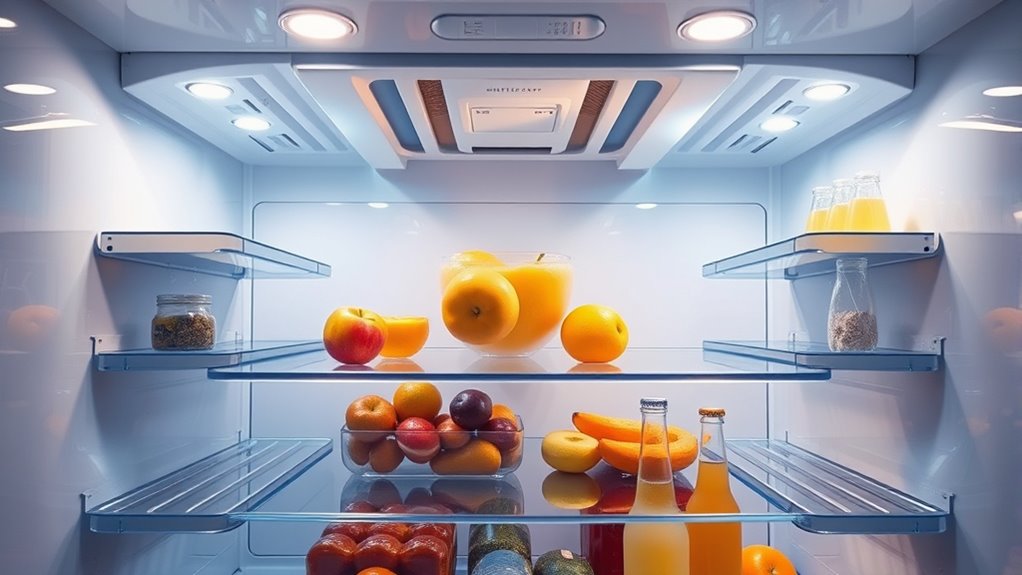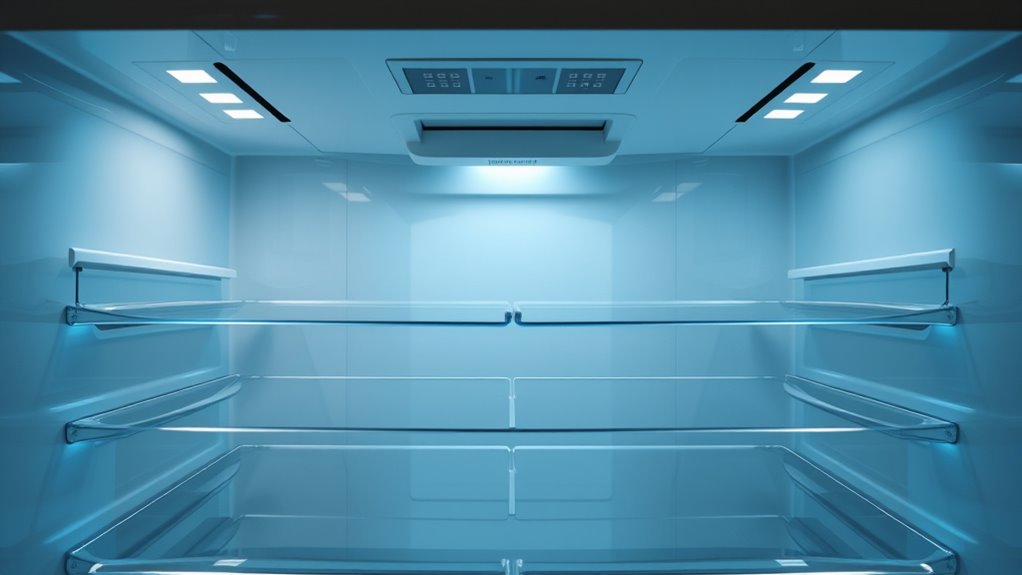To improve refrigerator airflow, focus on designing baffles with shapes that guide air efficiently, like curved or non-rectangular forms, to prevent turbulence and promote even cooling. Managing temperature stratification involves controlling airflow paths to reduce hot spots and ensure uniform temperature throughout the space. Using CFD simulations helps optimize baffle geometry and airflow rates. Exploring these design principles can reveal how to achieve better energy efficiency and consistent cooling, and you’ll discover more detailed strategies as you explore further.
Key Takeaways
- Proper baffle geometry directs airflow to prevent hot and cold zones, ensuring uniform temperature distribution.
- Curved and non-rectangular baffle designs disrupt boundary layers, reducing stagnation and promoting better mixing.
- Baffle spacing and orientation influence pressure drops and airflow paths, minimizing turbulence and vortex formation.
- CFD modeling helps optimize baffle shape and placement for efficient airflow and reduced stratification.
- Effective airflow management with well-designed baffles reduces temperature stratification, preserving product quality.
The Role of Airflow Baffles in Cooling Efficiency

Airflow baffles play a crucial role in enhancing cooling efficiency by directing and maintaining a consistent airflow curtain inside your refrigerator. They disrupt and redirect airflow, preventing cold air from collapsing toward the back and ensuring it flows evenly across all products. Properly designed baffles keep the cold air curtain stable, reducing turbulence and maintaining uniform temperatures. When baffles are correctly placed, they support even air distribution, minimizing hot and cold spots that can spoil perishables. They also help control humidity levels, essential for preserving freshness. Without effective baffles, the cooling curtain collapses, causing temperature inconsistencies. Additionally, airflow management is vital in preventing energy waste and ensuring the refrigerator operates at optimal performance. Proper airflow management also involves the strategic placement of baffles to optimize air circulation throughout the interior. Overall, airflow baffles optimize internal circulation, reduce energy consumption, and improve refrigeration performance by supporting a steady, effective cooling environment. Effective airflow management ensures that the refrigerator operates efficiently and keeps food fresh longer.
Tailoring Baffle Geometry for Optimal Air Movement

To optimize airflow, you need to ensure how baffle shape influences flow paths and mixing. Selecting the right materials and mounting methods guarantees stability and minimizes turbulence, improving overall efficiency. By tailoring these design aspects, you can achieve more uniform cooling while reducing pressure drops and mechanical stress. Additionally, understanding the impact of baffle geometry on airflow patterns allows for more precise control of temperature stratification within the refrigerator. Recognizing how color accuracy interacts with the environment can inform better design choices for airflow to prevent condensation and maintain temperature consistency.
Baffle Shape Optimization
Optimizing baffle shapes plays a essential role in directing airflow efficiently within a refrigerator. By choosing non-rectangular and curved designs, you can guide air more effectively toward critical cooling surfaces, improving heat transfer. Tailored profiles help prevent flow separation and stagnation zones, enhancing fluid mixing and reducing temperature stratification. Curved geometries disrupt boundary layers, lowering thermal resistance and boosting convective heat transfer. Adjusting spacing and orientation diverts airflow evenly across heat exchanger surfaces, decreasing vortex formation and backflow. Well-designed baffles increase airflow velocity in targeted zones, promoting better heat extraction and reducing frost buildup. Using computational tools like CFD allows you to test various shapes and parameters, ensuring your baffle design maximizes airflow efficiency and thermal performance. Incorporating personality traits can further enhance team collaboration during the design process by leveraging diverse problem-solving approaches.
Material and Mounting Methods
Choosing the right materials and mounting methods for your baffles directly impacts their effectiveness in guiding airflow and maintaining thermal performance. Use heat-resistant, lightweight metals like aluminum or engineered plastics that combine strength and thermal tolerance. Corrosion-resistant materials ensure durability over time. Adding reflective foil insulation can reduce heat transfer and enhance airflow control behind the baffle. Mount your baffles securely to sidewalls or floors near the coils, using screws, brackets, or existing wooden frames. Seal edges with foam or tape to prevent air leaks, guaranteeing proper directional flow. Mount the baffle bottom flush with the compartment floor for ideal airflow. Removable mounting options, like clips or screws, facilitate maintenance without disrupting airflow efficiency. Proper material choice and mounting are key to effective airflow management.
Understanding Temperature Stratification and Its Impact

Understanding temperature stratification is essential because it directly affects how evenly cold air distributes within a refrigerated space. Warm air rises due to its lower density, creating distinct temperature layers—hot near the top and cool at the bottom. This layering causes uneven temperatures, which can harm product quality and increase energy consumption, as the system overcompensates for warmer zones. Tall compartments and high height-to-diameter ratios worsen stratification, while limited heat transfer at walls prevents homogenization. If airflow isn’t managed properly, stratification can lead to frost buildup, system inefficiency, and equipment wear. Proper airflow solutions, such as airflow management techniques, can address these layers and improve temperature uniformity, energy efficiency, and product preservation. Additionally, monitoring temperature at different heights helps identify stratification issues and optimize system performance.
Leveraging CFD Modeling for Design Improvements

Computational Fluid Dynamics (CFD) modeling offers a powerful approach to improve airflow design within refrigeration systems. You can determine precise airflow rates and inlet temperatures to maintain target temperatures effectively. For example, simulating a flow rate of 200 l/min at -7.37°C helps achieve a stable internal temperature of 4°C. Steady-state CFD models reveal thermal behavior and cooling losses, guiding insulation and material choices. Time-dependent simulations assess how dynamic airflow adjustments impact temperature stability over time. Iterative CFD solutions allow you to refine inlet parameters continuously, enhancing performance. Additionally, CFD predicts ideal airflow patterns for uniform cooling, helping you position components like evaporators and fans strategically. This process ensures minimized temperature gradients and enhances overall refrigeration efficiency.
Managing Pressure Loss and Heat Transfer in Airflow Systems

Optimizing duct design and fin geometry is vital for managing pressure loss and heat transfer efficiency. Smooth duct passages and well-designed baffles reduce turbulence and static pressure drops, improving airflow. By carefully selecting fin shapes and arrangement, you can balance thermal performance with airflow resistance for ideal refrigerator operation. Incorporating smart home device integration can enable remote monitoring and control of airflow systems to maintain optimal conditions. Additionally, using Glycolic Acid benefits in skin treatments exemplifies how precise formulation enhances performance and safety.
Duct Design Optimization
Effective duct design requires careful management of pressure loss and heat transfer to guarantee system efficiency and comfort. To achieve this, focus on minimizing duct length and avoiding sharp bends, which cause turbulence and increase pressure drops. Use large radius bends to maintain airflow velocity and reduce noise. Proper duct sizing balances velocity—undersized ducts raise pressure and noise, while oversized ones reduce efficiency. Space constraints demand precise planning to maintain static pressure and minimize losses. Additionally, selecting suitable materials and sealing ducts properly prevents leaks that waste energy and disrupt airflow. Insulating ducts to R-8 limits heat conduction, improving overall efficiency. Proper insulation also helps in heat transfer management, reducing energy consumption. Use tools like Revit for accurate layout and sealing, ensuring consistent pressure and energy savings. Incorporating airflow management techniques further optimizes the system’s performance.
Fin Geometry Efficiency
Fin geometry plays a crucial role in balancing heat transfer efficiency with pressure loss in airflow systems. Closer fin spacing increases surface area, boosting heat transfer but also raises airflow resistance and pressure drop, demanding more fan power. Tight spacing can clog easily in dusty environments, increasing maintenance. Wider fin spacing lowers pressure loss and improves airflow, which is useful where forced convection is limited, but may require larger heat exchangers to maintain heat transfer. Fin shape also impacts performance; straight fins offer steady heat transfer, while serrated or wavy fins increase turbulence and surface area, enhancing heat dissipation but raising pressure loss. Material choice, like copper or aluminum, improves fin efficiency by optimizing thermal conductivity. Overall, fin geometry must be carefully designed to maximize heat transfer while minimizing pressure losses for efficient airflow management. Additionally, heat transfer efficiency can be significantly affected by the fin material and surface treatment, further optimizing system performance.
Practical Strategies for Uniform Air Distribution Inside Refrigerators

Achieving uniform air distribution inside a refrigerator requires implementing practical design strategies that guarantee consistent cooling across all compartments. You should incorporate multiple airflow vents spaced to cover every zone, ensuring even cold air delivery. Using fans with variable speed controls governed by temperature sensors allows for responsive airflow adjustments, maintaining stable conditions. Designing baffle geometry strategically directs airflow, avoiding dead zones and promoting thorough mixing. Additionally, optimizing shelf layouts and product placement minimizes airflow obstruction and reduces temperature stratification. Proper airflow management plays a crucial role in maintaining consistent temperatures throughout the refrigerator. These strategies work together to improve temperature consistency, extend food shelf life, and enhance energy efficiency. By focusing on vent placement, airflow control, and baffle design, you create a balanced environment inside your refrigerator for optimal cooling performance.
Frequently Asked Questions
How Do Material Choices Affect Baffle Durability and Airflow Sealing?
Your material choices directly impact baffle durability and airflow sealing. Choose durable, corrosion-resistant materials like stainless steel or high-quality plastics to prevent cracking, deformation, or wear. Smooth, low-thermal-expansion surfaces enhance sealing efficiency by reducing leaks, while flexible materials improve conformability to housing shapes. Selecting materials compatible with sealants and resistant to environmental factors ensures long-lasting, airtight seals, maintaining ideal airflow and preventing loss of cooling performance.
Can Adjustable Baffles Improve Airflow Control in Existing Refrigerators?
Think of adjustable baffles as the steering wheel of your fridge’s airflow, giving you control over its path. Yes, they can markedly improve airflow regulation in your existing refrigerator. By fine-tuning these baffles, you can direct cold air precisely where needed, eliminate hot spots, and optimize cooling efficiency. This hands-on control helps prevent temperature swings and keeps your food fresher longer, making your fridge smarter and more responsive to your needs.
What Are the Common Signs of Airflow Inefficiency in Refrigerator Systems?
You’ll notice airflow inefficiency in your fridge through signs like uneven cooling, frost buildup, or ice pockets inside compartments. If you see fluctuating temperatures, food spoiling early, or condensation on the exterior, it indicates poor airflow. Additionally, if fans run constantly or sound unusual, or if vents are blocked by food or debris, these also point to airflow issues that need addressing to maintain proper temperature.
How Does Ambient Temperature Influence Stratification and Airflow Design?
When ambient temperature rises like a blazing sun, it dramatically disrupts your refrigerator’s airflow, causing bold stratification and uneven cooling. You’ll notice warm layers sneaking into cold zones, making airflow design less effective. To fix this, you might need to boost airflow velocity or tweak baffle angles, ensuring heat doesn’t overwhelm your system. Adapting to higher temperatures keeps your fridge running efficiently and maintains uniform temperatures inside.
Are There Cost-Effective Methods to Retrofit Baffles for Better Airflow?
Yes, you can retrofit baffles cost-effectively using pre-made options like SmartBaffle insulation baffles, which are easy to install and affordable. Simply position them with a 2-inch chute for continuous airflow, secure with nails, and consider adding small fans for extra efficiency. These DIY solutions require minimal tools, save money, and improve your refrigerator’s performance by reducing heat buildup and energy use.
Conclusion
Think of your refrigerator’s airflow as a steady river guiding coolness throughout. When you tweak the baffle geometry and manage stratification, you’re like a skilled captain steering that river smoothly, avoiding turbulent whirlpools. Using CFD modeling is your compass, helping you navigate pressure loss and heat transfer. With these strategies, you guarantee a balanced flow, keeping your fridge’s interior as harmonious and invigorating as a gentle, unwavering current.









